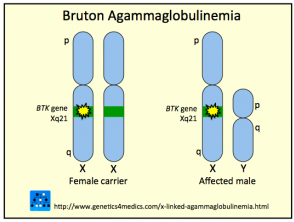What are gamma globulins?
Gamma globulins are also called immunoglobulins. They are proteins produced by plasma cells and are essential for the body's immune defense system. Agammaglobulinemia means the absence of gamma globulins.
What is X-linked agammaglobulinemia?
X-linked agammaglobulinemia is hereditary genetic disorder first described in 1952 by Dr. Ogden Bruton. It is characterized by the inability of the body to produce mature B-lymphocytes and plasma cells. Affected patients have severe deficiencies in all immunoglobulins.
X-linked agammaglobulinemia is also called Bruton's agammaglobulinemia.
What causes X-linked agammaglobulinemia?
X-linked agammaglobulinemia is caused by mutations at Bruton's Tyrosine kinase (BTK) gene, which was discovered in 1993. The gene normally promotes maturation of B lymphocytes. Since the BTK gene is found in the X-chromosome, X-linked agammaglobulinemia occurs exclusively in males. Females may have a autosomal recessive version of agammaglobulinemia.
Genetics of X-linked agammaglobulinemia

X-linked agammaglobulinemia
* Image courtesy of Genetics 4 Medics
What are the signs and symptoms of X-linked agammaglobulinemia?
Patients with X-linked agammaglobulinemia may have:
- Reduced lymphoid or reticuloendothelial organs, including the amygdala, lymph nodes, spleen, adenoids and intestinal Peyer's patches
- Recurrent respiratory infections, including otitis media, pneumonia, bronchitis or sinusitis; The most common causes are pneumococcus, strep, and staph.
- Chronic gastrointestinal symptoms, for example diarrhea due to giardia infections
- Skin infections
Babies with X-linked agammaglobulinemia appear healthy at first. They begin to have recurrent infections as protection from the mother. antibodies undress.
What are the risk factors for ax-linked agammaglobulinemia?
Risk factors for X-linked agammaglobulinemia include:
- Sex. The disease occurs exclusively in males.
- Years. The patient usually begins to have symptoms between 6 and 18 months of age.
- Family history.
- Race. It seems there is no racial predilection.
How is ax-linked agammaglobulinemia diagnosed?
X-linked agammaglobulinemia can be diagnosed by:
- Initial evaluation of serum immunoglobulins
- Measurement of B cells in peripheral blood, if the initial test reveals low serum immunoglobulins
- Molecular parsing, which involves techniques such as single string confirmation polymorphism, DNA analysis, denaturing gradient gel electrophoresisor reverse transcriptase polymerase testing in the BTK gene
- Genetic testing of female relatives of a patient suspected of X-linked agammaglobulinemia
- In the womb test through chorionic villus sampling or amniocentesis
- Tests at birth to detect a decrease in CD19 B cells and an elevated level of T cells by fluorocytometric analysis
What is the treatment for ax-linked agammaglobulinemia?
There is no cure for X-linked agammaglobulinemia. However, treatment can greatly improve the quality of life for patients with X-linked agammaglobulinemia.
- Forever immunoglobulin replacement therapy, administered intravenously or subcutaneously. This helps replace the antibodies that a patient with X-linked agammaglobulinemia cannot make on their own.
-
Antibiotics, sometimes used prophylactically, to reduce infection rates.
- Refraining from live vaccines, including the measles, mumps, and rubella (MMR) vaccine, and polio, rotavirus, and chickenpox vaccines, which can actually cause the diseases they are supposed to prevent.

